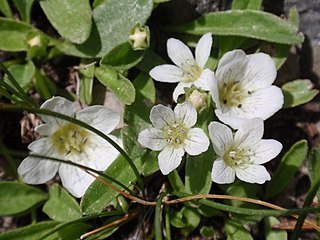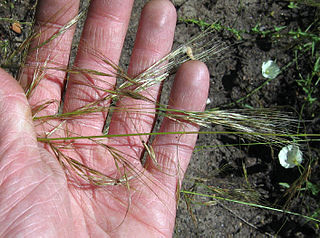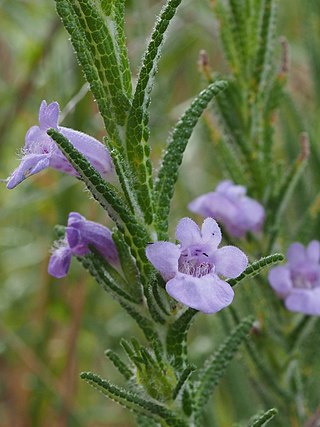
Nemophila is a genus found in the flowering plant family Boraginaceae.

Nemophila menziesii, known commonly as baby blue eyes or baby's-blue-eyes, is an annual herb, native to western North America.

Eriophyllum lanatum, with the common names common woolly sunflower, Oregon sunshine and golden yarrow, is a common, widespread, North American plant in the family Asteraceae.

Ribes malvaceum, the chaparral currant, is a member of the Grossulariaceae. It is native to California and northern Baja California, where it occurs from sea level to 1,500 metres (4,900 ft), in chaparral, foothill oak woodland, and closed-cone pine forest habitats.

Nemophila maculata, commonly known as fivespot, is a species of flowering plant in the borage family (Boraginaceae).

Nemophila spatulata, with the common names Sierra baby blue-eyes and Sierra nemophila, is a dicot in the family Boraginaceae.

Primula pauciflora, the pretty shooting star, few-flowered shooting star, dark throat shooting star or prairie shooting star, is a species of flowering plant in the primula family Primulaceae. It is a widespread and very variable species, native to western North America, from Subarctic America to Mexico, often in xeric and desert habitats. It is found in the Great Basin Deserts and Mojave Desert. Its synonyms include Dodecatheon pauciflorum and Dodecatheon pulchellum.

Heliotropium curassavicum, commonly called salt heliotrope, a species of flowering plant in the borage family (Boraginaceae). It is native to much of the Americas, from Canada to Argentina, including the West Indies and Hawaii. It can be found as an introduced, and sometimes invasive, species in Africa, Asia, Australia, and Europe. It thrives in salty soils, such as beach sand, alkali flats, and salt marshes. It is often found in disturbed coastal sites.

Malva parviflora is an annual or perennial herb that is native to Northern Africa, Europe and Asia and is widely naturalised elsewhere. Common names include cheeseweed, cheeseweed mallow, Egyptian mallow, least mallow, little mallow, mallow, marshmallow, small-flowered mallow, small-flowered marshmallow and smallflower mallow. It typically grows on agricultural lands and in disturbed sites such as roadsides.

Hesperevax sparsiflora is a species of flowering plant in the family Asteraceae known by the common name erect dwarf cudweed. It is native to California and Oregon, where it grows in several habitat types including sandy coastal areas and the serpentine soils of inland hills. This is a small woolly annual herb reaching maximum heights under 18 centimeters. It has oval to rounded or scoop-shaped leaves on short petioles which vary in morphology across varieties. Small flower heads appear between the leaves. They contain greenish or whitish disc florets.These florets are remarkably small, each being only 1/120th of an inch in width, and numbering 5 to 9 in the whole disc, which totals only 1/ 6th inch in width including bracts. This is the world's smallest composite inflorescence.

Fumaria muralis, known as common ramping-fumitory or wall fumitory, is a flowering herbaceous plant in the poppy family (Papaveraceae) native to western Europe and northwestern Africa.
Calycadenia pauciflora is a species of flowering plant in the family Asteraceae known by the common name smallflower western rosinweed. It is endemic to northern California, where it grows in the Coast Ranges north of the San Francisco Bay Area from Napa County to Tehama County, often on serpentine soils.

Hooveria parviflora is a species of perennial herb known by the common name smallflower soap plant. It is a monocot, native to coastal southern California and Baja California, where it is a member of the coastal sage scrub flora. It resembles a smaller version of Chlorogalum pomeridianum, with wavy leaves and white flowers that open during the day.
Nemophila pulchella, known by the common name Eastwood's baby blue-eyes, is a species of flowering plant in the borage family. It is endemic to California, where it is found from the San Francisco Bay Area to the southern Sierra Nevada to the Transverse Ranges. It grows in many types of mountain, foothill, and valley habitats.

Phyllostegia parviflora is a rare species of flowering plant in the mint family known by the common name smallflower phyllostegia. It is endemic to Hawaii, where it is known from Maui, Oahu, and the island of Hawaii. It is a federally listed endangered species of the United States.

Agave parviflora is a species of succulent perennial flowering plant in the asparagus family, known by the common names Santa Cruz striped agave, smallflower century plant, and small-flower agave. It is native to Arizona in the United States and Sonora in Mexico.

Nassella lepida is a species of grass known by the common names foothill needlegrass, foothills nassella, foothill stipa, small-flowered stipa, small-flowered needlegrass, and smallflower tussockgrass.

Chloanthes parviflora is a species of flowering plant in the family Lamiaceae. It is a small, rounded shrub with dark green, linear leaves and mauve tubular flowers. It grows in New South Wales and Queensland.
Commersonia parviflora, commonly known as small flowered rulingia, is a species of flowering plant in the family Malvaceae and is endemic to the south of Western Australia. It is a low, prostrate or dense shrub with wrinkled, egg-shaped leaves with rounded teeth on the edges, and clusters of small, white flowers.
















